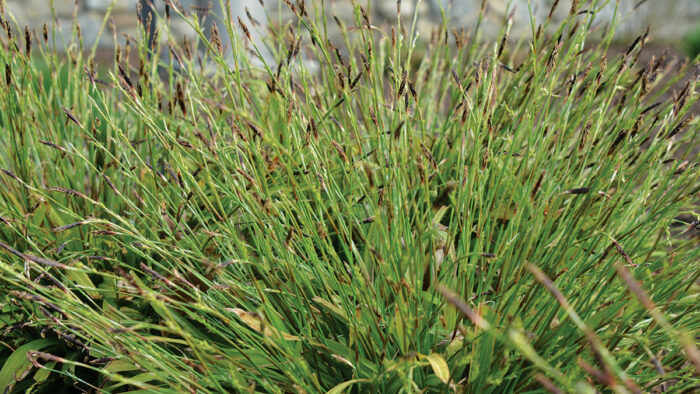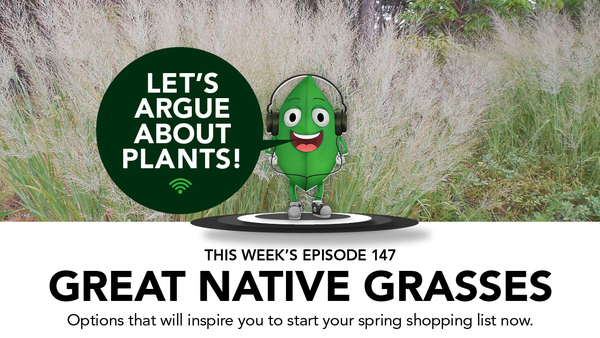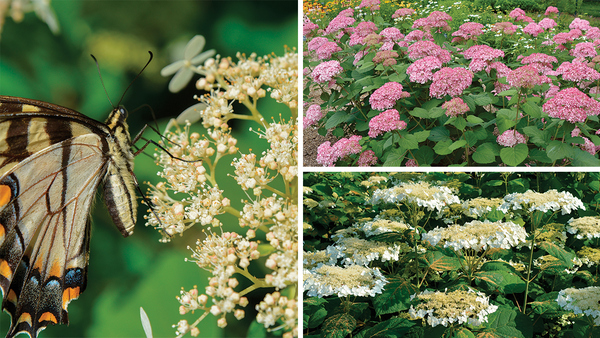
Throughout the wilds of North America, sedges can be found in almost every habitat, from mountaintops to shady wetlands to coastal sand dunes. This diversity of native habitats leads to great versatility in cultivation, giving these plants the ability to fill just about every landscape niche imaginable. They require minimal maintenance, with most species needing nothing more than a late-winter cutback. Sedges also contribute valuable ecosystem services by stabilizing soil and providing food and shelter for wildlife.
Mt. Cuba Center’s four-year Carex trial evaluated the horticultural qualities, vigor, and adaptability of 70 different native species and their cultivars. Plants were grown in shade and sun in average garden soil. Here are some of the ones that performed particularly well.
Wood’s sedge forms exceptionally dense mats of foliage
Carex woodii
Zones: 4–8
Size: 14 inches tall and 46 inches wide
Conditions: Full sun to full shade; average to moist, well-drained soil
Native range: Eastern and central North America
Wood’s sedge has taken the horticultural world by storm with its versatility and beauty and earned top marks in Mt. Cuba Center’s trial. It thrives in shaded settings but has also proven to be surprisingly adaptable to full sun. Its fine, blue-green foliage is topped with carpets of straw-colored flowers in late spring (inset photo), generally growing less than one foot tall. It spreads gradually via underground rhizomes, with established plants increasing about one foot in diameter each year. Wood’s sedge makes a perfect living mulch, gently weaving around the bases of taller perennials, and is better at suppressing weeds than similar species thanks to its dense mat-forming habit.
For tidy clumps of flowing foliage, plant common brome sedge
C. bromoides
Zones: 4−8
Size: 16 inches tall and 33 inches wide
Conditions: Partial shade; moist to wet soil
Native range: Eastern North America
Fine-textured common brome sedge performs exceptionally well in shade but also does well in full sun and even somewhat dry soil. Its adaptability makes it useful for unifying designs that span a spectrum of sun exposures and soil conditions. Over time, this species develops into strong clumps, with raised crowns reminiscent of prairie dropseed (Sporobolus heterolepis, Zones 3–8). It looks spectacular planted en masse and in unmowed sedge lawns. This species produces small, yellow-green spring flowers which add interest but quickly fade from view as the new flush of threadlike leaves takes center stage.
Upright sedge is a sun-loving species
C. stricta
Zones: 3–8
Size: 25 inches tall and 38 inches wide
Conditions: Full sun; average to wet soil
Native range: Eastern and central North America
Upright sedge, also commonly known as tussock sedge, is a sun-loving species seen in very wet locations throughout much of the eastern half of the United States. This species can even be found in standing water where the plant creates its own small tussock islands. Despite its predilection for saturated sites in the wild, C. stricta is also right at home in garden beds with average soil, rain gardens, or around the edges of water features. This fully deciduous species dies to the ground in winter; spring cleanup, which is optional, consists of simply removing the previous year’s straw-like foliage. In early spring, silvery spikes of new growth spear though the cold earth and give way to a breathtaking bouquet of gold and copper-colored flowers. Fading flowers are hidden by deep green leaves that remain attractive all summer.
Wide, pleated foliage sets plantain-leaf sedge apart
C. plantaginea
Zones: 3–8
Size: 6 to 12 inches tall and 10 to 12 inches wide
Conditions: Partial to full shade; moist to average soil
Native range: Eastern United States
One of the most easily recognized North American species is plantain-leaf sedge, thanks to its broad, beautifully textured foliage. It is perfectly suited to shaded locations but decidedly intolerant of full sun. When sited in a protected place, such as the north side of a house where it receives shade year-round, it will remain effectively evergreen with no spring cleanup required (inset photo). It’s an early bloomer, producing dark spikes of flowers in the middle of March, and while these flowers are not necessarily the showiest, they are a welcome reminder that spring is on the way.
Pennsylvania sedge is a crowd favorite for a reason
C. pensylvanica
Zones: 3–8
Size: 15 inches tall and 54 inches wide
Conditions: Full sun to full shade; moist to dry, well-drained soil
Native range: Eastern and central United States, and Canada
Popular Pennsylvania sedge is widely used in garden designs in part due to its versatility and adaptability. It thrives in a variety of sun exposures and soil conditions, as long as it is not too wet. Use it as a living mulch, or as a mowed or unmowed lawn alternative. It spreads slowly by underground rhizomes to create patches that increase by about 1 foot in diameter every growing season. Small gaps in the carpets of foliage can sometimes be exploited by weeds, but this trait can be used to a gardener’s advantage since it is more sociable with companion plants than the more competitive species. While the early spring blooms of Pennsylvania sedge are far from showy, a nativar called ‘Straw Hat’ produces an exceptional floral display on a slightly less spreading plant.
Cherokee sedge is tall and stately
C. cherokeensis
Zones: 6–9
Size: 35 inches tall and 60 inches wide
Conditions: Full sun to full shade; average to wet soil
Native range: Southeastern United States
Large, lovely Cherokee sedge is typically found in wet woodland conditions, but it adapts easily to average soil and even full sun. Wheat-like fruit adds a dash of summer interest and whimsy, but it’s the lustrous, emerald-green foliage that is the main attraction. It is effectively evergreen, although some leaf tips may burn in winter in a sunny location. Spring cleanup is a breeze; only a quick trim of the leaf tips is needed. A hard spring cutback is not recommended since new growth can be slow to emerge. Long-beaked sedge (C. sprengelii, Zones 3–5), which is closely related and can be utilized in similar ways, is slightly smaller and likely more cold tolerant.
Sam Hoadley is the manager of horticultural research at Mt. Cuba Center in Hockessin, Delaware.
Photos: courtesy of Mt. Cuba Center
Fine Gardening Recommended Products

Berry & Bird Rabbiting Spade, Trenching Shovel
Fine Gardening receives a commission for items purchased through links on this site, including Amazon Associates and other affiliate advertising programs.

The Nature of Oaks: The Rich Ecology of Our Most Essential Native Trees
Fine Gardening receives a commission for items purchased through links on this site, including Amazon Associates and other affiliate advertising programs.

isYoung Birdlook® Smart Bird Feeder with Camera
Fine Gardening receives a commission for items purchased through links on this site, including Amazon Associates and other affiliate advertising programs.



























Comments
Log in or create an account to post a comment.
Sign up Log in